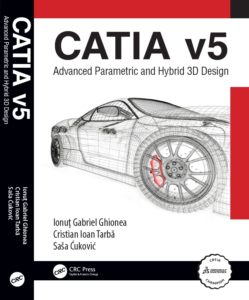CATIA v5: Advanced Parametric and Hybrid 3D Design
Authors: Ionut Gabriel Ghionea, Cristian Tarba and Saša Ćuković
About the book:
Language: English, First edition 2022
No. of pages: 556, 1028 B/W Illustrations
Dimensions (cm): 25.4 x 17.8, Hardcover
Printed version: ISBN 9781032250069
eBook version: ISBN 9781003281153
https://doi.org/10.1201/9781003281153
Publication location: Boca Raton, Florida, USA
Imprint: CRC Press, Taylor & Francis
Order the book here:
Routledge
Amazon.com
Amazon.co.uk
Barnes&Noble
Waterstones
Walmart
Click here for a long list of bookstores that sell the book and a growing list of universities that have the book in their libraries
This book is a part of the series of CAD tutorial books that presents the basic and advanced characteristics and working possibilities of modern computer-aided design software solution CATIA v5.
This tutorial book is intended to be not only used by students from faculties with a mechanical or industrial engineering profile but also by design engineers from various industries (automotive, aerospace, military, heavy machinery, medical technology, etc.) who need to work in this CAD
environment. Whether they are beginners or have a good experience in using CATIA v5, reading all written tutorials will help them to understand, upgrade and improve their knowledge and then to apply proven 3D modelling methods, to get familiar with many new modelling operations and options, by going step by step through the solutions explained for 3D modelling problems and those proposed for practising.
Based on our 20-plus years of teaching experience, we structured and wrote this book focusing on hybrid 3D modelling of many interesting parts. Each tutorial is a challenge for the reader and gradually presents different 3D modelling techniques, carefully explained and accompanied by clear figures, with annotations for a better understanding of the context. Thus, we use numerous graphical representations, drawings, screenshots, dialog boxes, icons of the tools, etc. Text and figures support the reader in understanding the approach and highlight all important selections (geometric elements or options). By presenting all phases of the modelling in a step-by-step manner, we explain a great number of options and strategies to model complex 3D surfaces, parametric solids and family tables, macros and Visual Basic Application (VBA) scripts.
All explanations and the collection of 3D examples included at the end of this book, in all their diversity, have been carefully selected to cover additional options, and some of them are followed by video tutorials presented in the Annexes, and near most of the proposed 2D drawings. Although many theoretical aspects are briefly explained to solve the 3D modelling problems easily, this book does not present all available commands and their options. Therefore, the reader is encouraged to further explore important sub-options encountered in the dialog boxes and then to search for some new modelling solutions for solving challenging parts.
To test the reader’s knowledge, the last chapter of this book contains 75 tests with their detailed answers, a scoring system (for self-assessment) and many 3D modelling problems for self-practising. Through the individual study, the reader is invited to model them in 3D because each part has an
educational scope and they have different degrees of complexity, shapes and functionalities.
From students to engineers, all are advised to open and follow the pages of this book with concern and perseverance, to patiently go through all the stages of the presented tutorials, to explore the proposed 3D models and then to successfully apply the knowledge acquired in their professional
activity.
The authors have made a consistent effort and passionately created all the written and video tutorials presented in this book, with great attention to detail. Several people, experts in other CAD programs, helped us create the content of this book. Our families, friends and colleagues from the university and industry supported us with patience and interest, and they proposed ideas and provided valuable observations, and we thank them for their time and feedback. The publisher (Taylor & Francis/CRC Press) also guided us with interest and professionalism to create a manuscript that will provide a great experience to our readers.
We hope that this book, by its content, will rise to the level of exigency that we set ourselves from the beginning and will be useful to all those who will have the curiosity and need to open it and learn from our knowledge.
We also challenge readers to send us other solutions for the presented 3D modelling problems and links to their own video tutorials and to contribute with their ideas and suggestions to improving the content of the future editions of this book.
The book is promoted on social media:
University Politehnica of Bucharest
Official CATIA LinkedIn
Claude Bourbigot LinkedIn
Ionut Ghionea LinkedIn
Sasa Cukovic web page
Refresh the page (press F5) if the video previews are not shown


